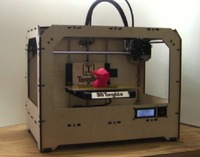 You have to look closely to tell the difference, because the TangiBot is very similar to a MakerBot Replicator. Extremely similar. In fact, it’s literally a clone.
You have to look closely to tell the difference, because the TangiBot is very similar to a MakerBot Replicator. Extremely similar. In fact, it’s literally a clone. Wait, what? How could the fine Replicator be cloned? It’s a project by Mechanical Engineer Matt Strong of Utah that’s currently on Kickstarter. Strong seeks USD$500,000 to set up a small production line dedicated to producing the TangiBot, a clone of MakerBot’s Replicator. At this point he’s a long way off, having just over USD$15,000 raised of that lofty goal with a few weeks to go.
First, why would one do this? According to Strong:
It offers the same great performance and features of the Makerbot Replicator but it costs roughly 2/3 what Makerbot charges you for it. Depending on the model you buy that is anywhere from $550-700 off! TangiBot is 100% compatible with all Makerbot Replicator firmware upgrades, parts and accessories.
Ok, but how is Strong allowed to do this? Doesn’t MakerBot own the rights to their own equipment?
Not exactly. MakerBot was able to produce their machines by building on top of open source software and hardware designs. But there’s often a requirement that comes along with using open source stuff: you must re-publish your improved designs to make them available to anyone and preserve the ongoing lineage and development of the concept. The MakerBot designs have been available all along, but no one bothered or could afford to take them to a commercial level. Until now.
All Strong needs is a wad of cash to establish the necessary tooling to get going. This may be a surprise to some and a disappointment to MakerBot fans, but we believe this to be an entirely legal move.
But what does this mean for MakerBot? We suspect not too much, unless Strong meets his goal, begins production and is able to grow to a significant size. In the meantime MakerBot will no doubt develop their own improvements and release new models that will decrease the demand for clones of their previous model.
Via Kickstarter

